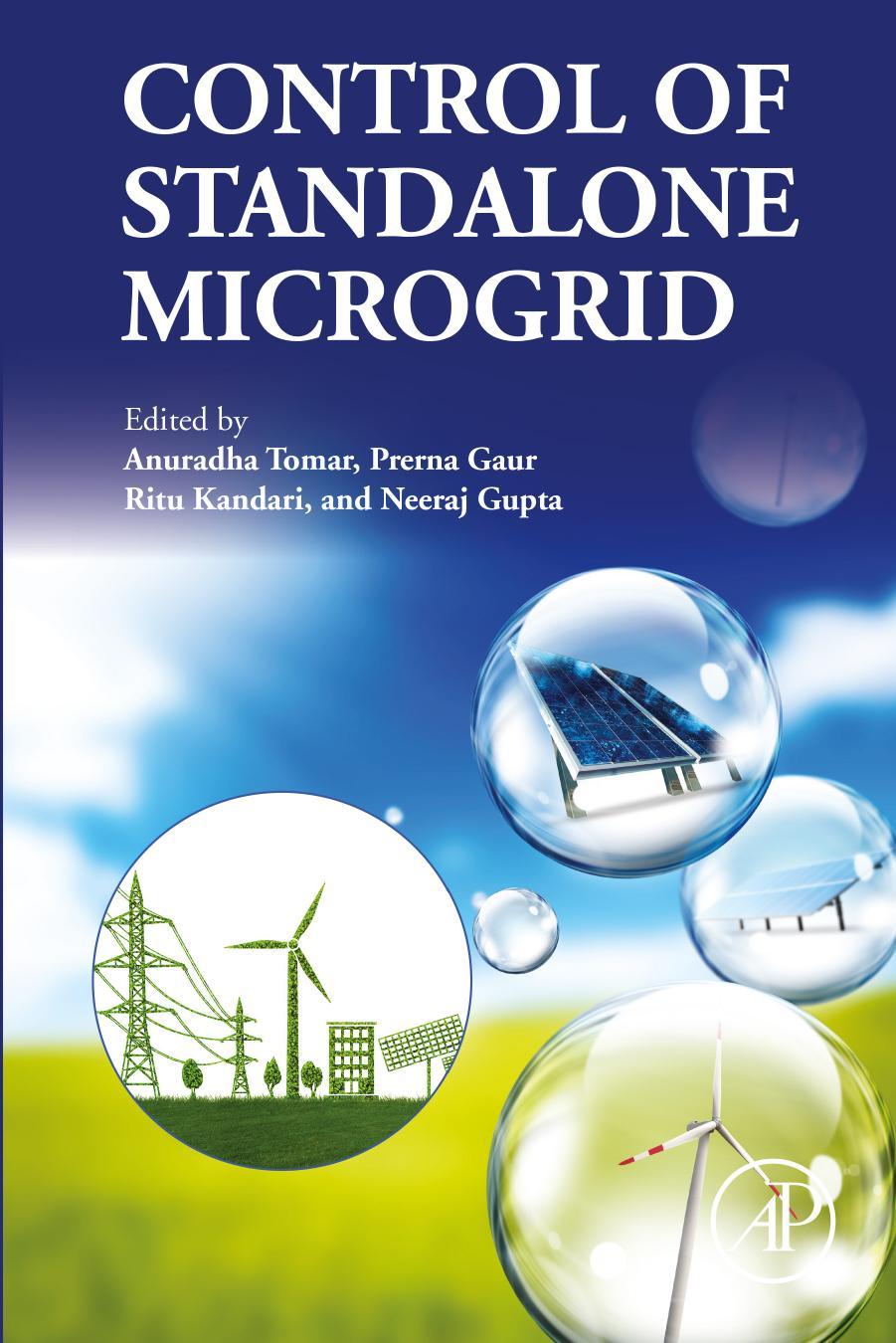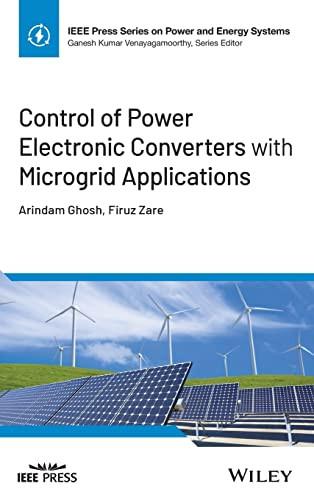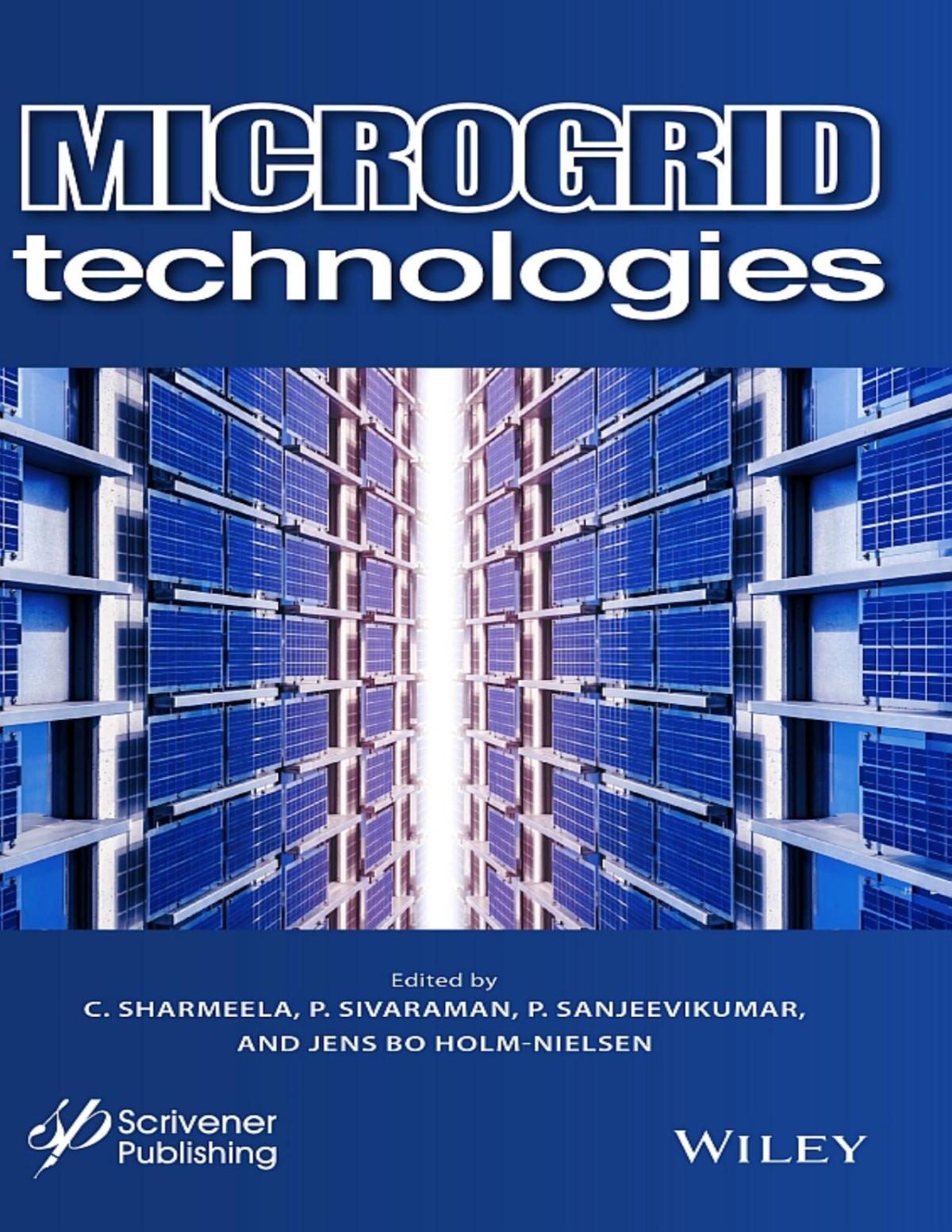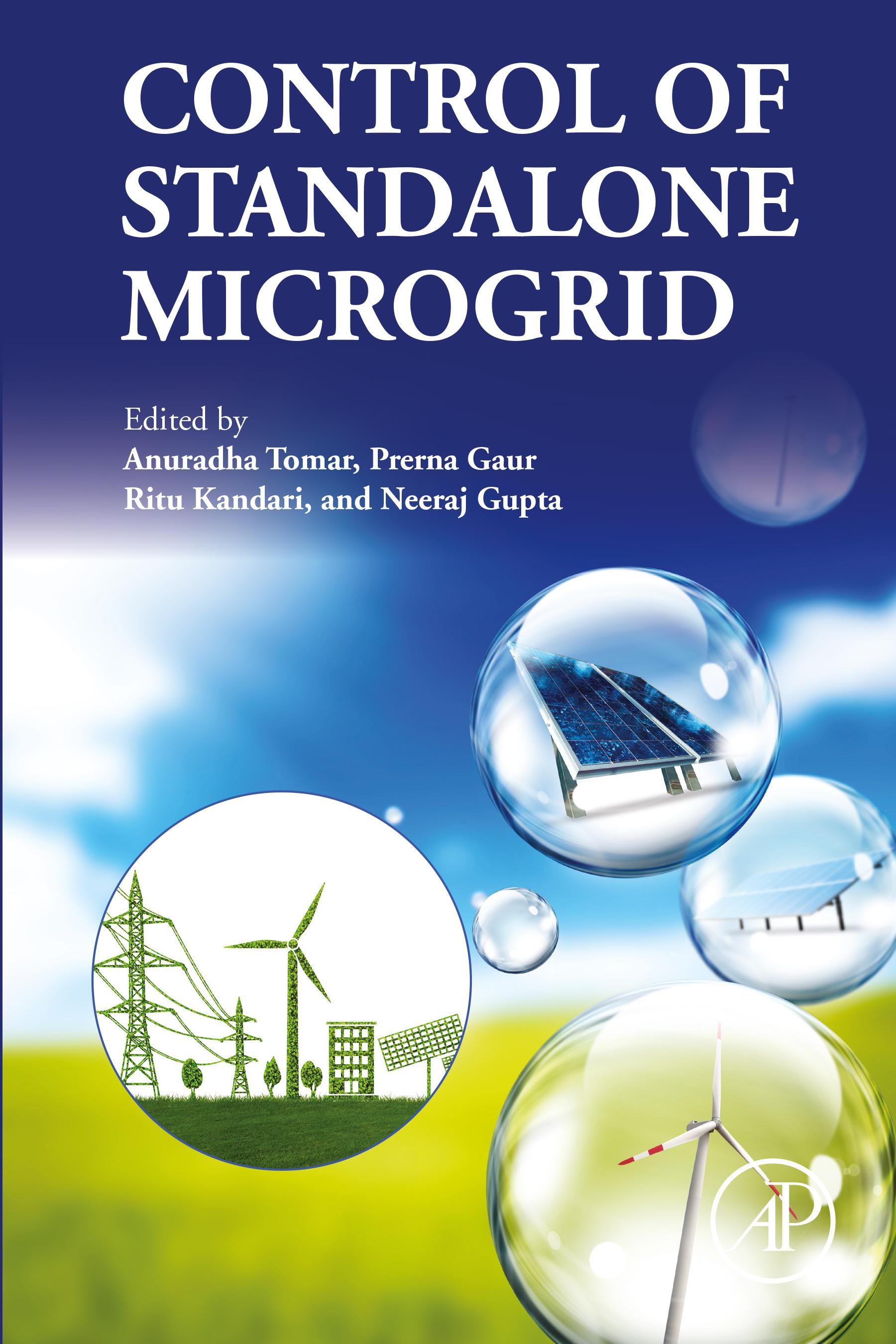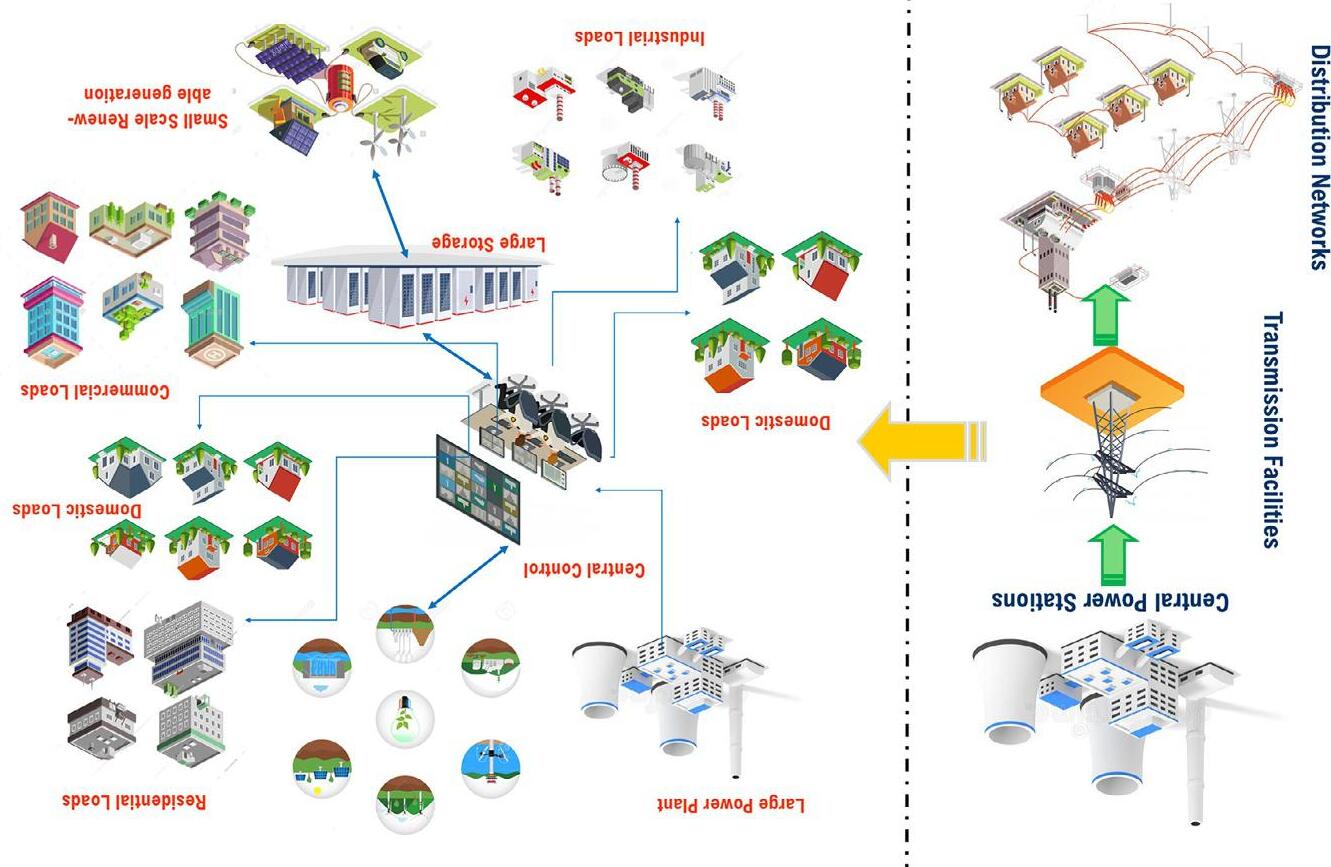ControlofStandalone Microgrid
Editedby AnuradhaTomar
NetajiSubhasUniversityofTechnology,Delhi,India
PrernaGaur
DirectorEastCampus,NetajiSubhasUniversityofTechnology, Delhi,India
RituKandari
DepartmentofElectronicsandCommunicationEngineering, IGDTUW,Delhi,India
NeerajGupta
ElectricalEngineeringDepartment,NationalInstituteofTechnology Srinagar,Srinagar,J&K,India
AcademicPressisanimprintofElsevier 125LondonWall,LondonEC2Y5AS,UnitedKingdom 525BStreet,Suite1650,SanDiego,CA92101,UnitedStates 50HampshireStreet,5thFloor,Cambridge,MA02139,UnitedStates TheBoulevard,LangfordLane,Kidlington,OxfordOX51GB,UnitedKingdom
Copyright©2021ElsevierInc.Allrightsreserved.
Nopartofthispublicationmaybereproducedortransmittedinanyformorbyanymeans, electronicormechanical,includingphotocopying,recording,oranyinformationstorageand retrievalsystem,withoutpermissioninwritingfromthepublisher.Detailsonhowtoseek permission,furtherinformationaboutthePublisher’spermissionspoliciesandourarrangements withorganizationssuchastheCopyrightClearanceCenterandtheCopyrightLicensingAgency,can befoundatourwebsite: www.elsevier.com/permissions.
Thisbookandtheindividualcontributionscontainedinitareprotectedundercopyrightbythe Publisher(otherthanasmaybenotedherein).
Notices
Knowledgeandbestpracticeinthisfieldareconstantlychanging.Asnewresearchandexperience broadenourunderstanding,changesinresearchmethods,professionalpractices,ormedical treatmentmaybecomenecessary.
Practitionersandresearchersmustalwaysrelyontheirownexperienceandknowledgeinevaluating andusinganyinformation,methods,compounds,orexperimentsdescribedherein.Inusingsuch informationormethodstheyshouldbemindfuloftheirownsafetyandthesafetyofothers, includingpartiesforwhomtheyhaveaprofessionalresponsibility.
Tothefullestextentofthelaw,neitherthePublishernortheauthors,contributors,oreditors, assumeanyliabilityforanyinjuryand/ordamagetopersonsorpropertyasamatterofproducts liability,negligenceorotherwise,orfromanyuseoroperationofanymethods,products, instructions,orideascontainedinthematerialherein.
LibraryofCongressCataloging-in-PublicationData
AcatalogrecordforthisbookisavailablefromtheLibraryofCongress
BritishLibraryCataloguing-in-PublicationData
AcataloguerecordforthisbookisavailablefromtheBritishLibrary ISBN978-0-12-823022-0
ForinformationonallAcademicPresspublications visitourwebsiteat https://www.elsevier.com/books-and-journals
Publisher: JoeHayton
AcquisitionsEditor: LisaReading
EditorialProjectManager: SaraValentino
ProductionProjectManager: PoulouseJoseph
CoverDesigner: VickyPearson
TypesetbySPiGlobal,India
1.Integrationofdistributedenergyresourcesinpower systems:Issues,challenges,technologyoptions,and theneedforresilience
AkankshaSharma,H.P.Singh,R.K.Viral,and NaquiAnwer
1.1Introduction 3
1.1.1Motivationandincitement4
1.1.2DER:Conceptandsignificance6 1.1.3Large-scalepenetrationofDERs7
1.2DERs:Technologyoptions 8
1.2.1DERapplications9 1.2.2Benefits11
1.3DERintegrationinexistingpowersystems:Impact andchallenges 12 1.3.1DERimpact13
1.4Needforincreasingtheresilienceofthegrid 17 1.5Recommendations:Thepathforwardinthe
2.Operationalandenvironmentalaspects ofstandalonemicrogrids
MasoodNazir,AijazAhmad,andIkhlaqHussain
2.2.1Planningofmicrogrids28
2.2.2EffectofintegratingDGswiththedistributiongrid29
2.2.3Voltagecontrol29
2.2.4Powerquality30
2.2.5Microgridprotection31
2.3Availabletechnologiesandtheirenvironmental concerns 33
2.3.1Availabletechnologies34
2.3.2Ongoingdevelopments38
2.4Operationalaspectsofdistributionsystems 39
2.4.1Distributionsystemsingeneral39
2.4.2Operationalissuesindistributionsystems40
2.4.3Operationalissuesinderegulation40
2.5Controlobjectives 42
2.6Environmentallyfriendlypowersystemincorporating microgrids 42
2.6.1Environmentalimpactsofconventional powerplants43
2.7Alleviationofenvironmentalproblemsbyusing DG-poweredstandalonesystems 44
2.7.1Higherefficiency44
2.7.2Decreaseingreenhousegases44
2.7.3Reducedhealthhazards45
2.7.4Reducedlanduse45
2.8Threatresponseofstandalonegrids 45
2.8.1Undesirableoccurrencesonpowergrids46
2.9Proposalsforimprovementinresilienceof stand-alonegrids 48
2.9.1Emergencycontrolandprotection49
2.9.2Distribution-levelrestoration50
2.9.3Renewableenergysourcesreadiness50
2.10Resultsanddiscussions 51
2.10.1VoltagedecrementwithoutDG52
2.10.2VoltageimprovementwithDG54
2.10.3Optimumcapacity54
3.Operationofunbalancedthree-phaseislanded microgrids
JhonA.Castrillon,JuanS.Giraldo,andPedroP.Vergara
3.2Modelingandcharacterizationofmicrogrids 69
3.2.1Mixed-integernonlinearprogrammingmodel69
3.2.2LinearizationsandtheMISOCPmodel73
3.2.3Solutionprocess75
3.3Casestudies 76
3.3.1Deterministicmicrogridoperation77
3.3.2Stochasticmicrogridoperation79
3.4Conclusion 80 References 81
4.ArobustDCmicrogridforresidentialbuildings
JaynendraKumar,AnshulAgarwal,NitinSingh,and AnuradhaTomar
4.1Introduction
4.3.1Hybridenergysources87
4.3.2Hybridenergystoragesystem91 4.3.3Interfacingdevices91
4.4ModelingoftheDCmicrogridcomponents 94
4.4.1ModelingofasolarPVarray95
4.4.2Modelingofafuelcell96
4.4.3Modelingofabattery96
4.4.4Modelingofasupercapacitor96
4.5Renewableenergysourcesconvertercontrol topologies 97
4.5.1SolarPVMPPTcontroller97
4.5.2Fuelcellstackpowercontroller97
4.6Powercontrolstrategy 99
4.7Simulationresults,discussions,andanalysis 102 4.8Conclusions
5.Scopeofarchitectureimprovementforstandalone microgrids
ManishaandPrernaGaur
5.1Introduction 113
5.2Definitionofamicrogrid 114
5.2.1Basicscomponentsofamicrogrid114
5.2.2Modeofoperation115
5.2.3Advantagesandchallengesofthemicrogrid116
5.3Typesofmicrogrid 117
5.4Microgridarchitecture 118
5.4.1DCmicrogrid118
5.4.2ACmicrogrid121
5.4.3Hybridmicrogrid122
5.4.4ACmicrogridwithDCstorage124
5.4.5DCzonalmicrogrid125
5.4.6Solid-statetransformer-basedmicrogrid127
5.5Currentmicrogridstandards
5.6Threeprincipleclassesofmicrogrids:Remote, associated,andnetworked
5.7Newinnovativekindsofmicrogrid
5.8Casestudies:Microgridsaroundtheglobe
5.9Futurescopeofmicrogrids
5.10Conclusion
6.Hierarchicalcontrol-I
AnuradhaTomarandAmrutaPattnaik
6.1Introduction
6.2Hierarchicalcontrol
6.3Advantagesanddisadvantagesanditsapplications
6.4Hierarchicalcontrolforstandalonemicrogrids
6.5Conclusion
7.Hierarchicalcontrolofislandedmicrogridwith dynamicloadpowersharing:Casestudies
MukulChankaya,IkhlaqHussain,andAijazAhmad
7.1Introduction
7.2Theproposedtopology
7.3Designandparameterselectionofenergystorage
7.4Controlof VDC, IBAT,and IUC
7.5ClassificationofVSCcontrol 157
7.5.1Timedomain-basedcontrolsoftheVSC157
7.5.2Frequencydomain-basedcontrolsoftheVSC158
7.5.3AdaptivecontrolsoftheVSC160
7.5.4PredictivecontrolsoftheVSC162
7.5.5Optimization-basedcontrols164
7.6Resultsanddiscussion 165
7.6.1Timedomain-basedcontrol165
7.6.2Frequencydomain-basedcontrol169
7.6.3Adaptivecontrols170
7.6.4Predictivecontrols177
7.6.5Optimization-basedcontrol178
7.7Conclusion 180 References 181
8.Coordinationcontrolofastandalonemicrogrid
PankajGupta,RituKandari,andAshwaniKumar
8.1Introduction 189
8.2Distributedenergyresources 190
8.2.1Microturbines191
8.2.2Electrochemicaldevices:Fuelcell191
8.2.3Windpowergeneration191
8.2.4Storagedevices192
8.2.5Solarpowergeneration192
8.3Conceptofthemicrogrid 193
8.3.1ACmicrogrid193
8.3.2DCmicrogrid194
8.3.3Hybridmicrogrid194
8.3.4Standalonemicrogrid195
8.4Casestudy:Coordinationcontrolstrategy 197
8.4.1ControlstrategyofaPVarray197
8.4.2Controlstrategyofabattery199
8.4.3Invertercontrol204
8.4.4Coordinatedcontrolofastandalonemicrogrid204
8.5Conclusions 215
9.SM-andFL-basedMRALFCschemesfor solar-wind-basedmicrogrid
PawanKumarPathakandAnilKumarYadav
9.1Introduction 218
9.2Solarphotovoltaic(SPV)system 221
9.2.1Modelingofasolarcell221
9.2.2ModelingofSPVmodule223
9.2.3P&OMPPTalgorithmforSPVsystem224
9.3WECS 225
9.3.1DynamicsofWT225
9.3.2MPPTtechniquesforWECS228
9.3.3Fuzzywindpowergenerationmodel(FWPGM)229
9.4Solar-wind-based μGsystem 231
9.4.1MRALFCschemeforsolar-wind-based μG231
9.5Resultsanddiscussion 236
9.6Conclusion 240
Contents
10.Adaptivecontrol-baseddroopcurrentregulator foraDCmicrogridsystem
JavedDhillonandSachinMishra
10.1Introduction
10.2Adaptivecontrol
10.3CasestudyforaDCmicrogrid
10.3.1PVpanelusedforthemicrogridsystem246 10.3.2ControllerusedforthePVsystem246
10.4Methodologyforadaptivedroopcontrol
10.5Resultsanddiscussions
11.Effectivecontrolarchitectureforamicrogrid hybridenergysystem
IramAkhtarandSheerazKirmani
11.1Literaturereview
11.3Proposedadvancedcontrolarchitectures
11.3.1Fuzzy-basedcontrolsystem264 11.3.2Modelpredictive-basedcontrolsystem268
11.4Resultsanddiscussion
12.Minimumorderdisturbanceobserver-aided integralslidingmodecontrollerforfrequency regulationofhybridpowersystem
VivekPatel,DipayanGuha,andShubhiPurwar
12.1Introduction
12.2ModelingofHPS
12.3.1Integralslidingmodecontroller280
12.3.2Minimumorderdisturbanceobserver281 12.3.3Stabilityanalysis286
12.4Resultsanddiscussion
12.4.1Case1:Studywithloadat t =5s286
12.4.2Case2:Studywithmultipleload288
12.4.3Case3:Studywithmultipleloadandwindpower perturbations290
13.Optimalschedulingofamicrogridusing AItechniques
PiyushJha,NipunSharma,VinayKumarJadoun, AnshulAgarwal,andAnuradhaTomar
Contributors
Numbersinparaenthesesindicatethepagesonwhichtheauthors’contributionsbegin.
AnshulAgarwal (83,297),DepartmentofElectricalandElectronicsEngineering, NationalInstituteofTechnologyDelhi,Delhi,India
AijazAhmad (25,149),DepartmentofElectricalEngineering,NationalInstituteof TechnologySrinagar,Srinagar,JammuandKashmir,India
IramAkhtar (257),DepartmentofElectricalEngineering,FacultyofEngineeringand Technology,JamiaMilliaIslamia,NewDelhi,India
NaquiAnwer (3),TeriSchoolofAdvancedStudies,NewDelhi,India
JhonA.Castrillon (63),DepartmentofSystemsandEnergy,UniversityofCampinas, Campinas,Brazil
MukulChankaya (149),DepartmentofElectricalEngineering,NationalInstituteof TechnologySrinagar,Srinagar,JammuandKashmir,India
JavedDhillon (243),SchoolofElectronicsandElectricalEngineering,Lovely ProfessionalUniversity,Phagwara,Punjab,India
PrernaGaur (113),InstrumentationandControlEngineeringDepartment,Netaji SubashUniversityofTechnology(formerlyNetajiSubashInstituteofTechnology, UniversityofDelhi),NewDelhi,India
JuanS.Giraldo (63),DepartmentofElectricalEngineering,EindhovenUniversityof Technology,Eindhoven,TheNetherlands
DipayanGuha (277),ElectricalEngineeringDepartment,MotilalNehruNational InstituteofTechnologyAllahabad,Prayagraj,India
PankajGupta (189),DepartmentofElectronicsandCommunicationEngineering, IndiraGandhiDelhiTechnicalUniversityofWomen,Delhi,India
IkhlaqHussain (25,149),DepartmentofElectricalEngineering,UniversityofKashmir, Srinagar,JammuandKashmir,India
VinayKumarJadoun (297),DepartmentofElectricalandElectronicsEngineering, ManipalInstituteofTechnology,MA HE,Manipal,Karnataka,India
PiyushJha (297),DepartmentofElectricalandElectronicsEngineering,Manipal InstituteofTechnology,MAHE,Manipal,Karnataka,India
RituKandari (189),DepartmentofElectronicsandCommunicationEngineering,Indira GandhiDelhiTechnicalUniversityofWomen,Delhi,India
SheerazKirmani (257),DepartmentofElectricalEngineering,FacultyofEngineering andTechnology,JamiaMilliaIslamia,NewDelhi;DepartmentofElectrical Engineering,FacultyofEngineeringandTechnology,AligarhMuslimUniversity, Aligarh,UttarPradesh,India
AshwaniKumar (189),DepartmentofElectronicsandCommunicationEngineering, IndiraGandhiDelhiTechnicalUniversityofWomen,Delhi,India
JaynendraKumar (83),DepartmentofElectricalEngineering,MNNITAllahabad, Prayagraj,India
Manisha (113),InstrumentationandControlEngineeringDepartment,NetajiSubash UniversityofTechnology(formerlyNe tajiSubashInstituteofTechnology, UniversityofDelhi),NewDelhi,India
SachinMishra (243),Sc hoolofElectronicsandElectricalEngineering,Lovely ProfessionalUniversity,Phagwara,Punjab,India
MasoodNazir (25),DepartmentofElectricalEngineering,NationalInstituteof TechnologySrinagar,Srinagar,JammuandKashmir,India
VivekPatel (277),ElectricalEngineeringDepartment,MotilalNehruNationalInstitute ofTechnologyAllahabad,Prayagraj,India
PawanKumarPathak (217),SchoolofAutomation,BanasthaliVidyapith,T onk, Rajasthan,India
AmrutaPattnaik (139),Dr.AkhileshDasGuptaInstituteofTechnologyand Management,NewDelhi,India
ShubhiPurwar (277),ElectricalEngineeringDepartment,MotilalNehruNational InstituteofTechnologyAllahabad,Prayagraj,India
AkankshaSharma (3),DepartmentofElectrical&ElectronicsEngg.,AmitySchoolof EngineeringandTechnology,AmityUniversityUttarPradesh,Noida,India
NipunSharma (297),DepartmentofElectricalandElectronicsEngineering,Manipal InstituteofTechnology,MAHE,Manipal,Karnataka,India
H.P.Singh (3),DepartmentofElectrical&ElectronicsE ngg.,AmitySchoolof EngineeringandTechnology,AmityUnive rsityUttarPradesh,Noida,India
NitinSingh (83),DepartmentofElectricalEngineering,MNNITAllahabad,Prayagraj, India
AnuradhaTomar (83,139,297),NetajiSubhasUniversityofTechnology,Delhi,India
PedroP.Vergara (63),DepartmentofElectricalEngineering,EindhovenUniversityof Technology,Eindhoven,TheNetherlands
R.K.Viral (3),DepartmentofElectrical&ElectronicsEngg.,AmitySc hoolof EngineeringandTechnology,AmityUnive rsityUttarPradesh,Noida,India
AnilKumarYadav (217),DepartmentofElectricalEngineering,NationalInstituteof TechnologyHamirpur,Hamirpur,HimachalPradesh,India
Chapter1
Integrationofdistributedenergy resourcesinpowersystems: Issues,challenges,technology options,andtheneedfor resilience
AkankshaSharmaa,H.P.Singha,R.K.Virala,andNaquiAnwerb aDepartmentofElectrical&ElectronicsEngg.,AmitySchoolofEngineeringandTechnology,Amity UniversityUttarPradesh,Noida,India, bTeriSchoolofAdvancedStudies,NewDelhi,India
Listofabbreviations
CG centralizedgeneration
CHP combinedheatandpower
DER distributedenergyresources
DESS distributedenergystoragesystem
DG distributedgeneration
GHG greenhousegases
GoI GovernmentofIndia
IOT internetofthings
NHPP nonhomogeneousPoissonprocess
RES renewableenergysources
RET renewableenergytechnology
SPV solarphotovoltaic
1.1Introduction
Theelectricpowersystemconsistsofunitsforelectricityproduction,devices thatmakeuseofelectricity,andapowergridthatconnectsthem.Theaimofthe powergridistoenablethetransportofelectricalenergyfromproductiontoconsumption,whilemaintainingacceptablereliabilityandvoltagequalityforall
ControlofStandaloneMicrogrid. https://doi.org/10.1016/B978-0-12-823022-0.00001-5 Copyright © 2021ElsevierInc.Allrightsreserved. 3
4 SECTION A Introductionofstandalonemicrogrids
customers,andallthisforthelowestpossibleprice.Asuddenchangeeitheron theproductionsideorontheconsumptionsidecouldendangerasituationwe havebecomesoaccustomedto.Modernsocietyisverymuchdependentonthe availabilityofcheapandreliableelectricity.Severalrecentblackoutsandprice peakshaveprovedthis.Therearedifferentreasonsforintroducingnewtypesof productionintothepowersystem(Wang,Ochoa,&Harrison,2010).Theterminologyusedtorefertothenewtypesofproductiondiffers:“embeddedgeneration,”“distributedgeneration(DG),”“small-scalegeneration,”“renewable energysources(RESs),”and“distributedenergyresources(DERs)”aresomeof thetermsthatareinuse.Thedifferenttermsoftenrefertodifferentaspectsor propertiesofnewtypesofgeneration.
Fromthestartofthe21stcentury,demandforreliableandsustainable energyhasbeenincreasingexponentially,leadingtothevastevolutionofthe generation,transmission,anddistributionofelectricity.Duetoincreasing demandandrisingenvironmentalissues,conventionalgenerationplantsneed toprovideanextraboosttoprovidereliableenergytoconsumers(Wang, Ochoa,&Harrison,2010).Thebasicstructureofacentralizedsystemanda distributedsystemisshownin Fig.1.1 (Moreno-Mun ˜ oz,DelaRosa,Lo ´ pez,& GildeCastro,2010).
1.1.1Motivationandincitement
TherecenttrendintheuseofDERs,alsotermedDG,isincreasingglobally, mainly,RESs.Deeplymotivatedbythepressuretoreducegreenhousegas (GHG)emissions,alleffortsrelatedtogenerationdependontheintegration ofRESsandalsovarioustypesofDERs(McCalley,Jewell,Mount,Osborn, &Fleeman,2011).Thisgrowthisbasedontheneedfortheenvironmental safety,security,andsustainabilityofenergysourcesandalsothefallingcost ofrenewableenergytechnologies.Incentralizedgeneration,electricityisgeneratedinlargeremoteplants.Powermustthenbetransportedoverlongdistancesathighvoltagebeforeitcanbeused.DERscanbedefinedaselectric powergenerationwithindistributionnetworksoronthecustomersideofthe network(Ackermann,Andersson,&S€ oder,2001).DERsystemsalwaysoffer abeneficialreplacementforconventionalenergysourcesforindustrial,commercial,aswellastraditionalapplications.TherearemanyreasonsforthewidespreaduseofDERsinenergysystemssuchas(Ackermann,Anderson,&Soder, 2000,2001; Barker&DeMello,2000; CIGREWorkingGroup,1998; CIRED-99,1999; Mark,2004; Taylor,Willis,&Engel,1997):
l Small-scalegenerationusingDERsrequiresasmallareaforinstallation.
l Asthesesystemsareplacedneartoconsumers,transmissionanddistributioncostsarereduced.
l ThefuelusedforDERsisreadilyavailable.
l HigherefficiencyismaintainedbytheDERsystem.
FIG.1.1 Centralgenerationversusdistributedgeneration(Moreno-Mun ˜ oz,DelaRosa,Lo ´ pez,&GildeCastro,2010).
ThemainfactormotivatingthegrowthofDERsiscostsavingandtheenhanced reliabilityoftheenergysystem.DERsmakeeconomicsenseinsituationswhere boththegeneratedelectricalenergyandtheprocessedheatareusedbythefacility.TheequipmentusedforDERsisavailableinawiderangefrom20kWto morethan200MW.Steam,naturalgas,fueloil,anddieseloilcanbeusedas generatorfuelandmanyprimemoverscanoperateondualfuels,therebycapitalizingonfuelsourcesthataremoreeconomical.
1.1.2DER:Conceptandsignificance
Theincreaseddemandforelectricityandtherisingincidencesofelectricity shortages,powerqualityproblems,blackouts,etc.havecausedcustomerstoseek high-quality,reliableoptionsforelectricity.DERisonesuchoption,andcanbe definedassmall-scalepowergeneration,locatedclosetotheconsumers,providingareliablealternativetothetraditionalpowergrid.Itisacombinationofthe installationandoperationofsmallpower-generatingtechnologiescombined withenergymanagementandstoragesystems.ThesizeofDERsrangestypically fromlessthanakilowatttoafewmegawatts.Thesesystemsmayormaynotbe connectedatthegridside.DERsaretypicallyrenewabletechnologiesdependent onbutnotlimitedtowindturbines,photovoltaiccells,microhydro,geothermal, etc.Thegrowthoftheseresources,mainlyRESs,hasbeenofprimeimportance globallybecauseofvariousfactorssuchassecurityandsustainabilityofenergy sources,environmentalfriendliness,availability,etc.
DERisnowacommontermintheenergyindustryandreferstosmall,dispersedgenerationresourceslikewind,solar,etc.DERscancompletelyneutralizetheelectricaldemandofcustomers,dependingonthesizeandconfiguration oftheDERsystem.Insomecases,theycanevenfeedbackexcesselectricityinto thetransmissionanddistributionsystem(DistributedEnergyResources,2018).
Although“distributedenergyresource”isacommontermintheenergy industry,nouniformDERdefinitionexists.Traditionally,DERsrefertosmall, geographicallydispersedgenerationresources,suchassolarorcombinedheat andpower(CHP),locatedonthedistributionsystem.Dependingontheirsize andconfiguration,distributedenergygenerationresourcescouldpartiallyor completelyoffsetconsumerelectricaldemand.Theycouldalsofeedsurplus energybackintothedistributionsystemor,insomecases,thetransmission system.
DERsareusedtocontrolsmallpowergenerationaswellasstorageprocessesinresidential,commercial,an dindustrialareas.Theyarealsoused byutilityproviders,individualcustom ers,andbusinessesfortheproduction andstorageofrenewablegeneratedpowerforbackup(TechTarget Homepage,2020).TheincorporationofDERsintothegridhasseveral benefits:
l CustomerswhohaveDER-generatedpowerexpecttopaylessfortheelectricityusedandcanalsosellpowerbacktothegrid.
l Incertainareas,wherethedependencyonwind,solar,oranyotherRESis high,DERscanbeusedtoprovideareliableandhigh-qualityservice(Tech TargetHomepage,2020).
DERscanincludebothbehind-the-meterrenewableandnonrenewablegeneration,energystorage,inverters,electricvehicles,othercontrollerloads, andalsonewtechnologieslikesmartmetersanddataservices.Thestructure ofaDERsystemisshownin Fig.1.2
1.1.3Large-scalepenetrationofDERs
Themajorfactorsbehindthegrowth,large-scalepenetration,andincreasing focusoftheintegrationofDERsintopowersystemsarebasicallyclassifiedinto threecategories: Environmentalreasons/factors:Themostimportantfactorthathasledto thegrowthanddevelopmentofthesustainableenergyenvironmentistheharmfuleffectsofconventionalenergygenerationontheenvironmentleadingto GHGemissions.Thereforetheforemostfactorleadingtothelarge-scalepenetrationofDERsistheenvironment.Accordingtotheliterature,thereareafew majorenvironmentalbenefitsleadingtothelarge-scalepenetrationofDERs (Akorede,Hizam,&Pouresmaeil,2010; PecasLopes,Hatziargyriou,Mutale, Djapic,&Jenkins,2007):
l ReductioninGHGemissionsduetopowergeneration.
l Minimizationofdamagetohealth.
l Avoidanceoftheconstructionofnewtransmissionlinesandlargegeneratingplants.
FIG.1.2 TypicalconfigurationofDERs.
DERscanbeusedtohelpthenationtoincreaseitsdiversityofenergysources (DistributedGenerationHomepage,2020).DERtechnologiessuchasthe renewableenergytechnologies—windturbinesandsolarphotovoltaics—have zeroconsumptionoffossilfuels.Apartfromthese,thereareotherenvironmentaladvantages,includinglownoise,lowemissions,andincreasedgreenpower.
Commercialviability:Uncertaintiesassociatedwithcompetitioninthe electricitymarketpayhugeinterestinsmallcapacitygenerationprojectswith lowfinancialrisks.Duetotheirsmall-scalenatureandlocationneartoend users,DGshaveahugebeneficialimpactonpowerqualityandreliabilityof thesystem(PecasLopes,Hatziargyriou,Mutale,Djapic,&Jenkins,2007).
Energysecurity:Theeconomicgrowth,automation,andmodernizationof thecountrymainlydependonthesecurityofenergysupply.Energydemand hasbeenincreasinggloballyandthereforethemainconcernistomeet futureenergydemands.Long-termprojectionsindicatethatenergydemand willrapidlyincreaseworldwide(Islam,Hasanuzzaman,Rahim,Nahar,& Hosenuzzaman,2014).Energysecurityhasbeenanimportantconcernfor policymakersduetothehighdependencyonsocietiesforenergyresources.
DERshaveaninterestingconceptwithrespecttoenergysecuritysuchas:
l TheideathatDERsareplacedclosetoconsumerstoprovideabenefitin caseoffailureofapowerstation,whichwillhavealimitedimpacton thewholesystemcomparedtolargepowersystemfailure.
l ByusingRESs,therewillbemorecontrolofenergysavingandsecurityof thenation.
1.2DERs:Technologyoptions
DER-basedsystemsaresmall-scalepowergenerationtechnologiesthatcanbe usedtoprovideanelevationinconventionalpowersystems.Thesesystemsare characterizedbyhighinitialcapitalcostperkilowattandcanalsobeusedas storagedevices,knownasdistributedenergystoragesystems(Distributed EnergyResources,2002a,2002b).
DERtechnologiesmainlyconsistofenergygenerationandstoragesystems, whicharelocatedneartoendusers.Distributedenergyencompassesahugerange oftechnologies,includingfuelcells,microturbines,loadreduction,andmanyother managementtechnologies.Italsoincludespowerelectronicinterfacesaswellas communicationsandcontroldevicesfortheefficientdispatchandproperoperation ofsinglegeneratingunitsaswellasmultiplesystems(Barney,2016).
DGcantakeplacegenerallyontwolevels:thelocallevelandtheendpoint level(Davis,2002).Local-levelgenerationincludesrenewableenergytechnologies,includingwindturbines,geothermal,solarsystems,hydrothermalplants, etc.Thistypeofgeneratingplantissmallerthancentralizedpowerplantsandis alsomorecostefficientandreliable(Davis,2002; DG,2020a).Thesetypesof plantstakeintoaccountlocalresources,whichareusuallylessharmfulto theenvironment(DG,2020b).However,inendpoint-levelgeneration,many
FIG.1.3 DGtechnologies(Barney,2016; Davis,2002; DG,2020a).
similartechnologiescanbeappliedalongwithfrequentlyemployedtechnologies(DistributedGenerationHomepage,2020).Attheuserlevel,thesetechnologiescanoperateasislandsforenergyproductionandserveascontributorsto thegrid(DistributedGenerationHomepage,2020; Viral&Khatod,2012).VariousDGtechnologiesareshownin Fig.1.3 (Barney,2016; Davis,2002; DG, 2020a)andelaboratedin Table1.1.
1.2.1DERapplications
Generally,DERapplicationsdependontherequirementsofanindividualcustomer.However,therearecertainapplicationswhereDERsarecommonly used.Someoftheseapplicationsare(DER,2020a; Viral&Khatod,2012): Continuouspower:DERisoperatedcontinuouslyforabout6000hayear forgeneratingpoweronacontinuousbasistofulfillthecharacteristicsofefficiency,lowmaintenancecosts,andlowemissions.Thistypeofcontinuous poweriscurrentlyusedforindustrialapplicationshavinglowthermal demands.
CHP:CHPisalsoknownascogenerationorcooling,heating,andpower. DERtechnologyisusedforCHPtogeneratesomeorallitspower,whereas someDERwasteheatisusedforheatingwater,steamgeneration,andmany otherthermalneeds.Thistypeofapplicationprovideshighthermaloutput, lowmaintenancecosts,andlowemissions.Thisapplicationisalsomainlyused byindustries.CHPapplicationsaremorecommonthancontinuouspower applications.
Greenpower:ThemostcommonapplicationforDERsistoproducegreen powerandreduceharmfulemissions.Greenpowercanbeusedbyenergygeneratingcompaniesforcustomerswhodemandpowergenerationwithlow emissions.

